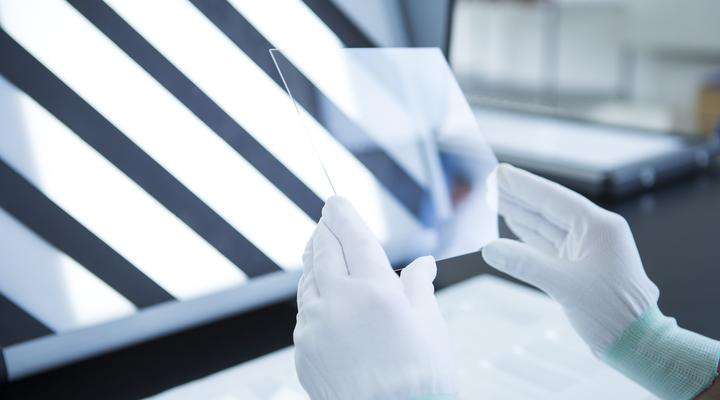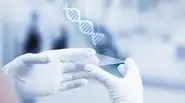
A glass full of hope
A daily fight against disease
The fact that biology loves exceptions is something Dr. Christoph Schröder sees every morning at his breakfast table. Though statistics are part of the daily work routine of a scientist, he just shrugs his shoulders and grins when he watches his children – three boys and each one unique. They are the loud proof that nature’s whim is once again full of surprises.Afterwards, the molecular biologist heads towards Building 583 in Neuenheimer Feld – an area of the city just north of the Neckar River – at the university campus in Heidelberg. There, he makes his way down to the underground floor. Schröder unlocks the glass door. He is Managing Director of the biotech company Sciomics, which specializes in antibody microarrays and was founded in 2013. Together with his small team of eleven professionals, he analyzes the impact of protein changes for the diagnosis or therapy of different diseases. With help from complex antibody microarrays, the startup offers innovative services for medical research, diagnostics, and industry.
“To know that we can take our scientific findings and do something to help, that we can do something in the fight against cancer and other diseases, motivates each of us every day,” says Schröder. “But we are also well aware that it takes quite some time before results can reach the patients.”
Medical research with a startup attitude
Within the science campus, Sciomics has rented a floor in the basement. The offices are furnished with a lot of dedication in the style of an innovative startup. A number of analysis charts, protein distributions, and flyers with study results hang on the walls. In the hallway there are red, yellow and green armchairs, whose colors mirror the company logo, and also hint at the process of protein analysis with the help of fluorescent dyes.With its lab area, Sciomics distinguishes itself from other startups such as those found in the IT segment. Nevertheless, the entrepreneurial spirit is clearly evident in the daily work performed.
Developing a method for sequencing the human hereditary material while he worked as a postdoc at the Imperial Cancer Research Fund in London was the reason why Hoheisel concentrated on the development of microarrays. He has continued working in this field since 1993 at DKFZ.

It all begins with the analysis: Dr. Ronny Schmidt carefully prepares the proteins.
The science behind antibody microarrays
It quickly became clear that slides made of glass could play a decisive role. The underlying principle of antibody microarrays is simple. Proteins are detected as fluorescent spots of light. The resulting pattern provides conclusive information whether specific proteins are strongly or weakly present in a patient sample or not at all. Thus, biomarkers can be identified which are not only useful in the diagnosis and the selection of a therapy, but may also help in winning crucial time in the race to beat the disease from further advancing.Tiny spots of known proteins or antibodies – which are just a few micrometers in size – are placed on the slides. In fact, several thousand droplets can be put on the glass and analyzed simultaneously. Proteins from cancer tissue, serum and urine samples are labelled with fluorescent dyes before they are also placed on the prepared slides.
By scanning the microarrays, the binding reactions can be visualized on display screens in red and green points. The objective of this process is to detect indications of cancer in the blood long before the outbreak of the disease. “Cancer is a genetic disease, a mistake in the genetic material,” explains Dr. Hoheisel.
“That tends to really complicate things,” admits Hoheisel, who was supported by Schröder in the development. For his dissertation, the Sciomics Managing Director examined twelve different surfaces for the analysis. Right from the start, NEXTERION® glass slides from SCHOTT came very close to meeting the vision of the scientists. The optimization took place while working with the special glass manufacturer as part of his doctorate and later at his postdoctoral work. “We worked side-by-side on this,” recalls Schröder about the development project.
Dr. Mohamed Alhamdani from the DKFZ was also there to provide support. “At some point, it quickly became apparent that the epoxysilane coating was the best option for our requirements,” recalls the Group Head for the area of Affinity Proteomics. “The background noise was high, but thanks to SCHOTT, we were able to optimize the coating.”
Driving life science research with glass
How glass can have an impact is something that SCHOTT has been demonstrating in other life science segments. Whether it is specialty glass for pharmaceutical packaging, the latest fiber optic system and lighting solutions for analysis devices, or bioactive glass, SCHOTT offers pioneering products for a diverse array of medical applications.In the development of antibody microarrays, the high-grade substrate and a broad coating capability played a significant role in obtaining reliable and reproducible diagnostic results. Antibody arrays are incredibly smart tools, yet to achieve conclusive results, an accurate raw material can make all the difference.
Proteins have the unpleasant property of binding rather non-specifically. When 10,000 microscopically tiny protein droplets are placed on a glass slide, it is essential that they remain stuck to the desired spot and not react with the surrounding coating. This effect is also required during the subsequent incubation with proteins from cancer cells, blood or urine; a protein should only bind to an antibody at its respective place.
“There should not be any signal occurring between the spots. NEXTERION® glass slides have allowed us to accomplish what previously was never possible to this extent with other products,” says Hoheisel. “The product performs just super. And now we are applying the method to find biological information.”

Latest analytical devices support researchers in their daily work.
A scientific success story
The same is true for Sciomics, where biomarker signatures created by antibody microarrays identification became commercially viable and grew into a successful business. The method’s immense potential was already clear during its development, which has led to two valuable patents: one on the diagnosis of pancreatic cancer, the other on the prognosis of bladder cancer. Thanks to a sufficient number of orders, Sciomics was able to finance itself even in the early years. Customers include academic groups, large international research institutes, university clinics, doctors performing research, and biotech and pharma companies.
Coated substrates are subjected to a contact angle measurement in order to guarantee consistent high-quality coatings.
Different problems, different solutions
“We do not have a typical customer,” notes Schmidt. “Each project is completely different. Our platform enables us to support a huge variety of biomedical studies and diseases. Quite often it leads to a further co-development with our customers.”From the very start, Sciomics was an international company. In fact, this year less than 10% of its sales have been generated from within Germany. Sciomics takes a holistic approach. Microarrays are not simply produced and then handed over to the customer; instead, Sciomics offers to provide scientific support. “From others, I get a proposal, but with Sciomics, I am given a solution,” is what Schröder hears again and again. Every customer is a partner, Sciomics wants to offer intensive assistance, which includes planning of the study, the analysis, and the compilation of a comprehensive and scientific report.
The Sciomics analysis method
“It is our unique selling point,” says Schmidt. The main work for researchers begins as soon as the microarrays have been scanned. Every tiny colored spot is made up of many pixels. For every pixel, there is a numeric value, which describes the intensity. For every microarray, 500,000 numbers can be derived. For 50 samples, this means 25 million data points. The job of correctly assigning and interpreting them belongs to Schmidt and the molecular biologist Camille Lowy.“In contrast to other proteome analysis techniques, the Sciomics method allows for robust high-throughput analyses of various parameters on several molecules in minute volumes,” Lowy explains.
Shifting the timeline for early diagnosis
Both the DKFZ and Sciomics are certain that antibody microarrays will be the key to moving the diagnosis to a much earlier point in time and combine it with a prognosis. “How early before the actual disease onset can we detect potential problems based on the respective pattern with the biomarkers so that we are actually in a position to say ‘Yes, there is ongoing tumor development’?” Hoheisel says.Dr. Christoph Schröder follows the same approach. “We want to be able to simultaneously measure several proteins from blood samples in order to achieve a faster and more detailed diagnosis,” explains the Managing Director of Sciomics.
Though it is still a long way before personalized medication is going to be a reality, patients can be treated more individually since a classification into more distinct groups is possible. Innovative packaging solutions such as SCHOTT’s iQ™ platform, which enables the smallest batches to be filled efficiently, lay the groundwork for new treatments.
The future of life science research
Smaller formats for microarrays and three-dimensional surface structures are just a few of the many approaches that can be taken for the advancement of technology. “We are so grateful that there are manufacturers like SCHOTT which are very active here,” says Schmidt. “Together we can accomplish a lot.”By optimizing the surface, it may even be possible to further increase the sensitivity of the arrays, as well as the reproducibility and the binding capacity. The outcome: signal intensity could increase and the result would become finer and more exact. Once again, these are small but vital steps in the battle to end cancer.
An important marketing tool for Sciomics is attending conferences and trade exhibitions, as well as visiting customers. On a small map of the world, Schröder has marked the places he has already visited during these business trips. Vacation spots are missing. “There is hardly any time for that,” insists Schröder, before announcing that he will soon be taking a few days off for vacation with his family at a farm. And when he watches his boys romping around there, he knows exactly what his daily research means for future generations: new hope for a life without cancer.
Used materials
Find out more about NEXTERION® glass substrates and discover our range of related products.As part of SCHOTT MINIFAB, the unique portfolio of borosilicate glass substrates branded under NEXTERION® are ideal for a wide variety of DNA, protein and cell applications. Available with a range of functional coatings, from epoxysilane for peptides and antibodies to aminosilane for oligonucleotides, NEXTERION® glass substrates are used for a number of diagnostic and life science applications, and is highly customizable upon request.







